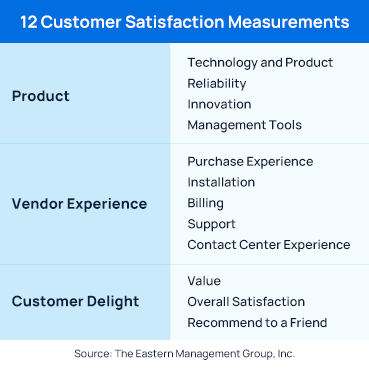
This is a guest blog by John Malone, President & CEO of The Eastern Management Group.
From business school, I recall that taglines create an image that customers will carry in their heads to the checkout line. I thought of this adage when I was recently briefed by unified communications (UC) company Yeastar on their new branding campaign, “Digital Value, Delivered.” The new campaign promises a pleasant digital transformation journey for every customer.
But just what comprises the pleasant digital transformation journey, and how do customers grade trip performance? In other words – does Yeastar’s new campaign create an effective image?
It’s a lot to assess, so follow along.
Digital transformation is not confined solely to implemented technologies. It’s also about practices—about how companies integrate it into their global organizations, so the adoption process for digital-oriented technology is crucial for the transformation.
And why is this crucial? The M.I.T. Sloan Management Review explains:
- Digital transformation is necessary for economic reasons/ Maintaining the ability to cope with other competitors regarding new digital products or providing other beneficial processes.
- Digital leaders are more attractive to employees. Companies must transform their working environment to become digital leaders.
- Employees want to work for digital leaders.
Yeastar’s new campaign is about the future of work and the role Yeastar plays: “Yeastar empowers businesses to communicate and collaborate anywhere anytime effortlessly.” In other words, Yeastar promises an easy and pleasant digital transformation journey.
Architectures and Applications
Henry Ford, concealing a truth while pitching the Model T, popularized that customers don’t require a choice. Any color was available from Ford as long as it was black. Production lines need compromise, hence a solitary shade, to improve efficiency and quality. Ford was the 1909 progenitor of the one-size-fits-all product approach—in today’s parlance, UCaaS for everyone.
The Eastern Management Group monitors 44 unified communications providers. Many share a lane with Henry Ford, finding it expensive to build more than one UC platform. A second platform is costly to train for, develop, manufacture, stock, sell, and support. A training program alone can set a manufacturer back a million dollars.
An on-premises PBX manufacturer with sights set on developing a companion UCaaS platform can spend millions for a class 5 switch and possibly three years in development before seeing revenue. The converse applies to a UCaaS provider adding a premises platform. The economy in platforms is antithetical to Yeastar’s business. The company is part of a small cadre of unified communications manufacturers making both on-premises and UCaaS products.
In my briefing, Yeastar claimed: “With cloud service, hardware, software, and as-a-service offerings, we ensure our customers always have the best approach for their transformation.” Yeastar says the company assures customers it removes barriers to a connected and collaborative digital workplace. It sees value in offering customers seamlessly fitted premises and cloud architectures, promising it delivers products and services for unified communications, collaboration, workplace scheduling, and a hybrid workplace.
The UC Market Is Not Shifting Solely to the Cloud
Many vendors say UC is shifting to the cloud. But where is the timetable? Or are clouds just setting in?
Eastern Management Group research shows that in 2027, 37% of UC system sales will be UCaaS. Premises systems represent the remainder: 38% on-prem, 11% hybrid, and 15% server virtualization. On-premises being 64% of 2027, shipments will never go away based on our analysis.
If neither the market for on-premises UC nor UCaaS is going away, as I have written about before and examined in our global study Unified Communications Market 2022-2027, Yeastar’s two-platform approach makes a lot of sense.
Every provider’s decision to build just one UC platform or two makes a difference and needs to be understood by customers.
Some enterprises are better served with an on-premises PBX, some with UCaaS, and some with both, possibly, when branch locations must be networked. The myriad issues influencing which option to pick—include cost, ease of using applications, interoperability, security, dealer logistics, support, network connectivity, tariffs, regulations, training, capitalization, and IT manager preference.
Many multi-location businesses benefit from both premises and cloud UC; this addressable market is significant. The U.S. Census reports 160,000 multi-establishment businesses representing almost 2-million affiliated establishments. We think 10% of these companies may use both on-prem and cloud UC.
Hybrid Work Entails Multiple Methods of Collaboration
Yeastar’s marketing strategy centers on hybrid work as the future of work and Yeastar’s role in positioning its customers for that future. Eastern Management Group research corroborates this. In a recent survey, we invited several hundred thousand IT managers to forecast their company’s hybrid work plans in 3-5 years. Overall, companies expect 44% of their employees will be doing hybrid work by then. In other words, while telework of the kind the pandemic prompted has fallen from 35% of the workforce in May 2020 to 10% in March 2022, hybrid work is enduring.
Yeastar further explains that hybrid work entails collaboration.
Eastern Management Group examined some Yeastar applications for their ability to improve enterprise productivity. There is empirical evidence to support the following productivity gains for enterprise customers using similar features:
- Collaboration—Up to 10% productivity improvement
- Presence—Decision speed improvement and up to 10% productivity improvement
- Video—company travel costs reduced by 25%.
- Unified messaging—25-50% cost savings on multiple platform costs
UC Provider Report Card
Enterprises on a digital transformation journey might think Yeastar is onto something. Yeastar beat the UC average as defined by our data in the Eastern Management Group 2022 Unified Communications Customer Satisfaction survey. In measurements of innovation, management tools, purchase experience, installation, billing, support, contact center experience, overall satisfaction, and recommend-to-a-friend. 100% of Yeastar’s UCaaS customers surveyed would recommend the company to a friend and earning Yeastar the Eastern Management Group 2022 Top Rated UCaaS Customer Satisfaction Award for Recommend-To-A-Friend.”
Such satisfaction may well support Yeastar’s tagline: Digital Value, Delivered.
About the Survey
The Eastern Management Group surveyed over 5,000 IT manager customers of 44 UC vendors for our CSAT report 2022 Unified Communications Customer Satisfaction. Respondents judged their UC provider in 12 Customer Satisfaction Measurements (see chart below).

*This article was originally posted on No Jitter.
